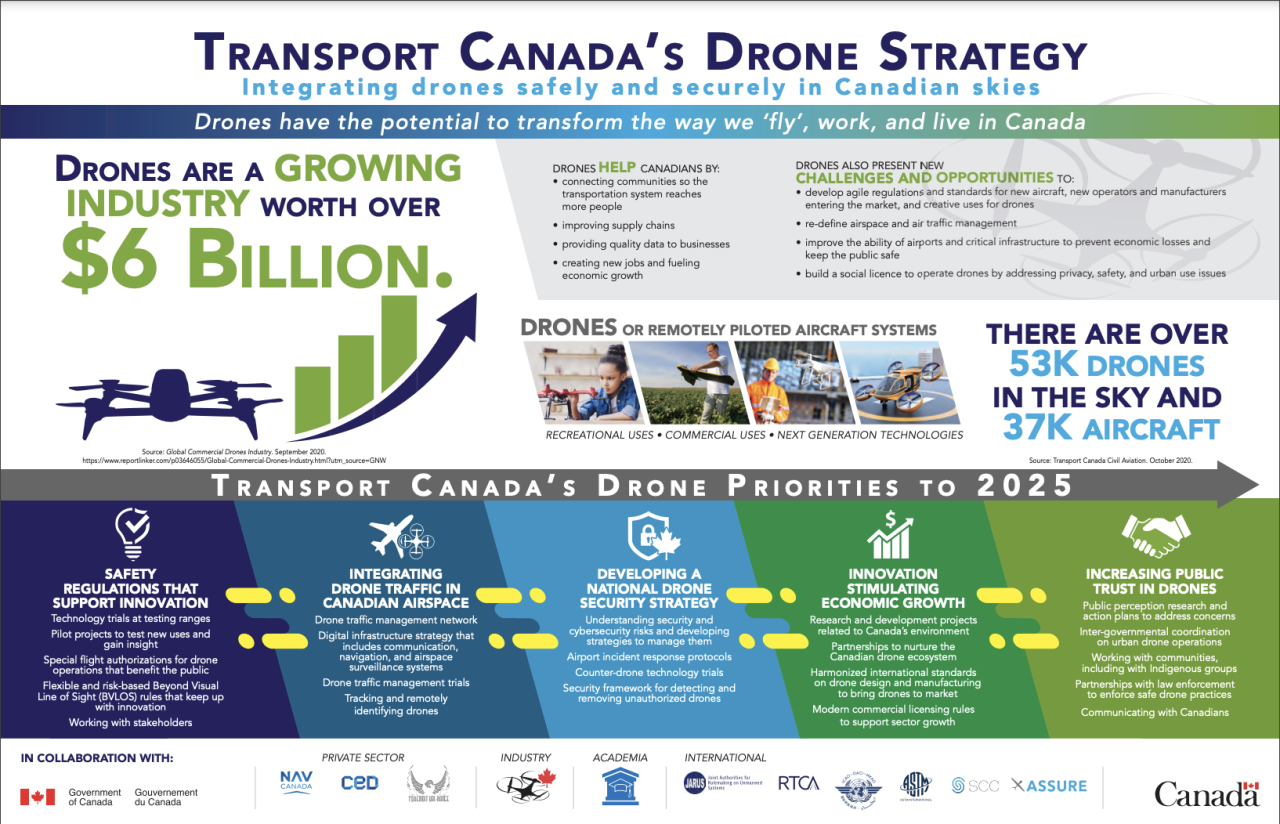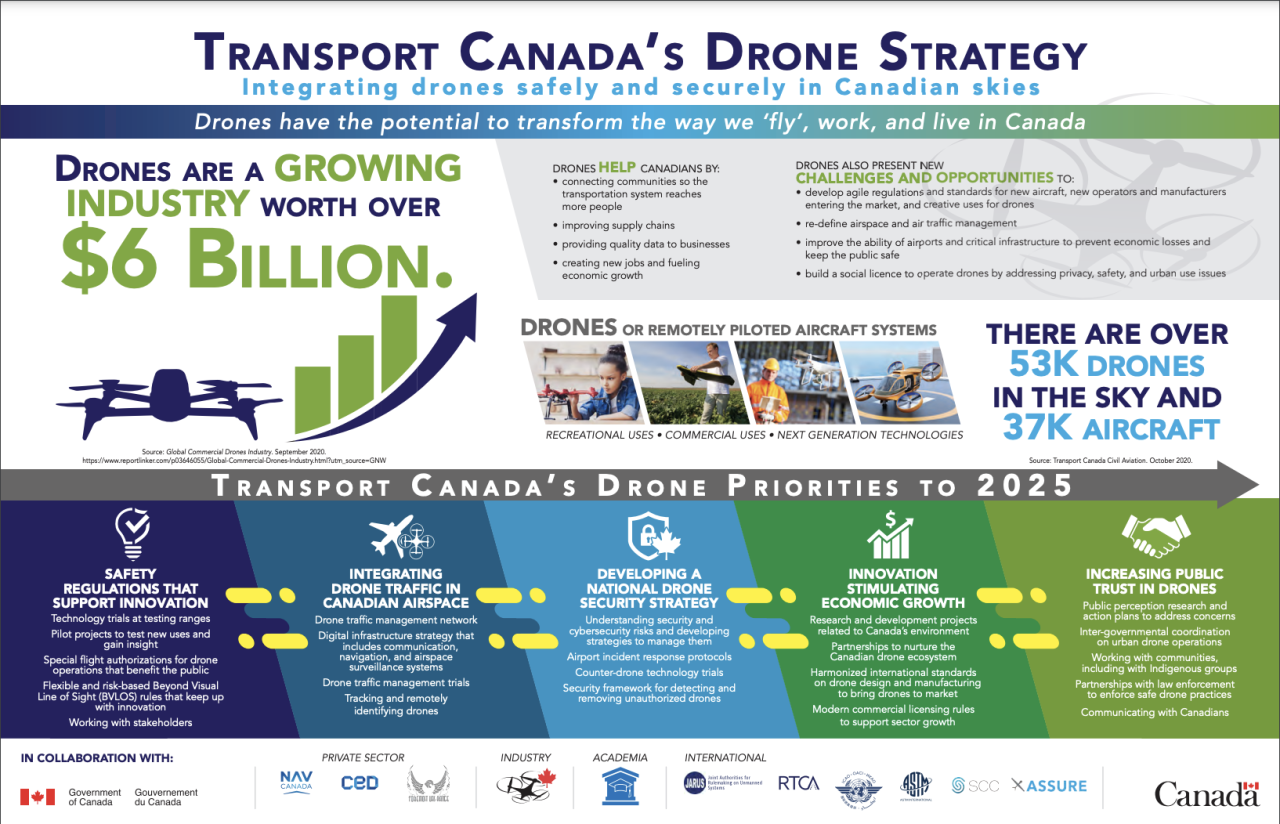Drone delivery Canada stock presents a fascinating investment opportunity, riding the wave of technological advancement and burgeoning e-commerce. This sector is poised for significant growth, but understanding the regulatory landscape, technological hurdles, and market competition is crucial for informed decision-making. We’ll explore the key players, market trends, and potential risks associated with investing in Canadian drone delivery companies.
This exploration will cover publicly traded Canadian companies involved in drone delivery, analyzing their market capitalization, recent stock performance, and future prospects. We’ll also delve into the regulatory environment in Canada, comparing it to international standards and discussing potential future changes. Furthermore, we will examine technological innovations driving the industry, analyzing market size, growth potential, and the competitive landscape.
Finally, we’ll examine case studies of successful and unsuccessful drone delivery initiatives, providing valuable insights for potential investors.
Canadian Drone Delivery Stocks: A Comprehensive Overview

The burgeoning drone delivery sector in Canada presents exciting investment opportunities, but also significant risks. This overview examines publicly traded Canadian companies involved in drone delivery, the regulatory landscape, technological advancements, market analysis, investment prospects, and case studies of successful and unsuccessful initiatives.
Publicly Traded Canadian Drone Delivery Companies

Several Canadian companies are actively involved in the drone delivery space, though the publicly traded ones are relatively few. The following table summarizes key details about these companies. Note that market capitalization and stock performance are dynamic and subject to change. This data should be verified with up-to-date financial information from reputable sources.
| Company Name | Stock Symbol | Market Cap (Illustrative Example – Verify with Current Data) | Recent Stock Performance (Illustrative Example – Verify with Current Data) |
|---|---|---|---|
| [Company Name 1 – Replace with Actual Company Name] | [Stock Symbol 1 – Replace with Actual Stock Symbol] | $[Market Cap 1 – Replace with Illustrative Market Cap] | [Recent Performance Description 1 – e.g., “Up 5% in the last month”] |
| [Company Name 2 – Replace with Actual Company Name, if applicable] | [Stock Symbol 2 – Replace with Actual Stock Symbol, if applicable] | $[Market Cap 2 – Replace with Illustrative Market Cap, if applicable] | [Recent Performance Description 2 – e.g., “Down 2% in the last quarter”] |
Regulatory Landscape for Drone Delivery in Canada
The regulatory environment significantly impacts the growth of drone delivery in Canada. Transport Canada sets the rules for commercial drone operations, focusing on safety and security. These regulations cover aspects such as pilot licensing, drone registration, operational limitations (e.g., flight altitudes, distances, and airspace restrictions), and data privacy.
Compared to some other countries, Canada’s regulations are considered relatively robust but are constantly evolving. For example, while some countries might have more lenient rules regarding beyond visual line of sight (BVLOS) operations, Canada prioritizes a phased approach, focusing on safety protocols and technological advancements before widespread BVLOS implementation. Future changes might involve easing certain restrictions as technology matures and safety records improve, potentially stimulating investment and market expansion.
Conversely, stricter regulations could slow down growth.
Technological Advancements in Canadian Drone Delivery
Technological innovation is crucial for the success of drone delivery. Canadian companies are actively developing and deploying advanced technologies to enhance efficiency, safety, and reliability. These advancements are addressing challenges specific to the Canadian climate, such as harsh weather conditions and vast distances.
- Improved Battery Technology: Longer flight times are crucial for wider delivery ranges, especially in sparsely populated areas.
- Advanced Navigation Systems: Enhanced GPS and sensor technologies improve precision landing and autonomous flight capabilities, even in challenging weather.
- Weather-Resilient Drone Designs: Drones are being designed to withstand snow, ice, and strong winds, crucial for Canadian conditions.
- Automated Package Handling Systems: Streamlined loading and unloading processes increase efficiency and reduce human intervention.
- Drone Traffic Management Systems (UTM): These systems help manage and coordinate drone flights in shared airspace, preventing collisions and enhancing safety.
These advancements directly impact efficiency by reducing delivery times and costs, and enhance safety by minimizing risks associated with manual operation in challenging environments.
Market Analysis of Drone Delivery in Canada

The Canadian drone delivery market is still in its early stages, but significant growth potential exists. Market segments include healthcare (delivering medications and medical supplies), e-commerce (delivering small packages), and remote communities (providing access to essential goods and services). The competitive landscape is relatively fragmented, with both large established companies and smaller startups vying for market share.
Projected Market Growth (Illustrative Example): The following description illustrates a hypothetical market growth graph. Actual data would need to be sourced from market research reports. Imagine a line graph with years (2024-2028) on the x-axis and market size (in millions of CAD) on the y-axis. The line would show a steady upward trend, starting at, say, $50 million in 2024 and increasing to $250 million in 2028.
Thinking about investing in drone delivery Canada stock? It’s a hot market, but understanding the tech is key. Before you jump in, check out what’s available for consumers – like the drones you can find at best buy drone – to get a better grasp of the technology’s current capabilities and limitations. This will help you make a more informed decision about drone delivery Canada stock’s potential for growth.
This represents a significant compound annual growth rate (CAGR) indicating substantial market expansion potential.
Thinking about investing in drone delivery Canada stock? It’s a hot market, but remember to do your research! If you’re a Telus customer, you might want to check out their loyalty program by calling the telus loyalty phone number for potential discounts – that could free up some cash for your drone delivery investments. Once you’ve got your finances sorted, you can dive deeper into analyzing the drone delivery Canada stock market.
Investment Opportunities and Risks in Drone Delivery Stocks, Drone delivery canada stock
Investing in Canadian drone delivery stocks offers the potential for high returns, but also involves substantial risks. Opportunities stem from the growing market, technological advancements, and potential regulatory changes. However, the sector is still relatively nascent, making it volatile.
Key risks include regulatory uncertainty, competition, technological challenges (e.g., battery limitations, weather dependency), and the possibility of slower-than-expected market adoption. A thorough due diligence process, including careful evaluation of individual company financials and risk profiles, is crucial before investing.
Case Studies of Successful and Unsuccessful Drone Delivery Initiatives in Canada
Analyzing successful and unsuccessful drone delivery programs provides valuable insights into best practices and potential pitfalls. This information helps investors assess the viability and risk profiles of different companies and projects.
| Company | Initiative | Outcome | Key Factors |
|---|---|---|---|
| [Company Name 3 – Replace with Actual Company Name] | [Description of Initiative 1 – Replace with Actual Initiative] | [Success/Failure – Replace with Actual Outcome] | [Key Factors Contributing to Outcome – Replace with Actual Factors] |
| [Company Name 4 – Replace with Actual Company Name, if applicable] | [Description of Initiative 2 – Replace with Actual Initiative, if applicable] | [Success/Failure – Replace with Actual Outcome, if applicable] | [Key Factors Contributing to Outcome – Replace with Actual Factors, if applicable] |
Epilogue: Drone Delivery Canada Stock
Investing in drone delivery Canada stock offers both significant potential rewards and inherent risks. While the market is experiencing rapid growth fueled by technological advancements and increasing demand, navigating the regulatory complexities and competitive landscape requires careful consideration. By understanding the key players, market dynamics, and potential pitfalls, investors can make more informed decisions and potentially capitalize on the exciting opportunities within this emerging sector.
Thinking about investing in drone delivery Canada stock? A big player in the drone industry you should keep an eye on is dji canada , as their technology often influences the market. Understanding DJI’s advancements helps you better assess the potential and challenges facing companies involved in drone delivery services in Canada, ultimately informing your investment decisions.
Remember to always conduct thorough due diligence before making any investment choices.
Answers to Common Questions
What are the main risks associated with investing in drone delivery stocks?
Risks include regulatory uncertainty, technological challenges (e.g., battery life, weather limitations), competition, and the overall volatility of the stock market.
How is the Canadian drone delivery market regulated?
Transport Canada sets regulations governing commercial drone operations, focusing on safety and airspace management. These regulations impact operational costs and expansion plans for drone delivery companies.
What is the projected growth of the Canadian drone delivery market?
Growth projections vary, but many analysts predict significant expansion over the next five years, driven by e-commerce growth and technological improvements.
Are there any tax implications for investing in Canadian drone delivery stocks?
Tax implications depend on individual circumstances and should be discussed with a qualified financial advisor. Capital gains taxes may apply upon selling your shares.
